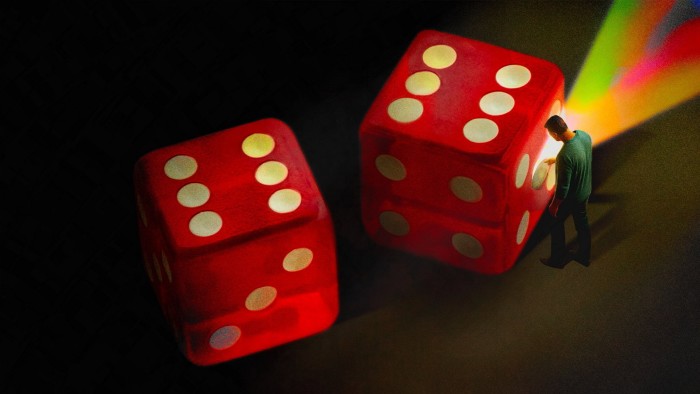Stay informed with free updates
Simply sign up to the Artificial intelligence myFT Digest — delivered directly to your inbox.
The writer is professor of mathematics at the University of Oxford and author of ‘Blueprints: How Mathematics Shapes Creativity’
Our kitchen at home is decorated with a series of coloured tiles. We installed it just after I’d seen Gerhard Richter’s exhibition “4900 Farben”, where he filled 196 canvases with five-by-five grids of coloured squares placed according to chance. Wanting to mimic this, I decided to arrange our tiles using the decimal expansion of pi which starts 3.14159 . . . and then heads off to infinity with a string of numbers that satisfies all the criteria for a random sequence.
However, when my wife reviewed my plan, she was unimpressed because: “You can’t have three red tiles next to each other.” I protested that randomness creates these unexpected clusters, but her artistic eye prevailed. The result is a kitchen that looks random but subtly avoids repeated colours, shaped more by her design than by mathematical chance.
That experience made me wonder whether Richter had similarly intervened in his own work. But my mathematical analysis of his 196 canvases revealed he had truly surrendered to randomness. He’s not alone. Many artists in the 20th and 21st centuries have used chance as a creative tool. The Dada movement famously explored its potential to push art in new directions in the early 20th century. John Cage and Karlheinz Stockhausen used it to compose music. William Burroughs and David Bowie employed randomness to write text.
Why does randomness appeal to artists? Many through the ages have embraced mathematical structures such as the golden ratio, symmetry or hyperbolic geometry as frameworks for creativity. Randomness seems the opposite: an anti-structure. Yet it’s precisely that unpredictability that some find liberating.
Richter used randomness to highlight its fascinating property: it produces apparent patterns and clumpings that tempt the mind to find hidden meaning. “What I like about the patterns are they’re not constructed on the basis of an ideology or religion,” he observed. “The patterns which emerge by coincidence contain all sorts of associations.”
For Dadaists, randomness was political. To them, the first world war was the outcome of rationalism, capitalism, and aesthetic dogma. By embracing chance, they aimed to break from those systems. Jean Arp, a Dada pioneer, saw randomness as a way to bypass the conscious mind — a gateway to new, unfiltered creativity.
Today, artificial intelligence can play a similar role. While debates often focus on AI replacing artists, its real power is as a collaborator, offering fresh perspectives shaped by the artist’s past work. Jazz pianist Bernard Lubat trained an AI model on his own improvisations, and when he jammed with it in concert he found himself in a familiar yet unexplored sound world.
Music has a long history with chance. Even Mozart composed a work in which each bar was chosen by the throw of dice. The skill of the composer was to create music that worked however the dice landed. One motivation was to allow the player to feel part of the creative process. These “dice games” let them help generate the music, resulting in pieces probably never heard before. Often the results sound somewhat mediocre, however — and this echoes the challenge with AI-generated content: much of it is unremarkable. Still, occasionally randomness produces something interesting.
One striking literary example is BS Johnson’s 1969 novel The Unfortunates, which consists of 27 chapters in a box. Apart from fixed opening and closing chapters, the reader assembles the remaining 25 in any order, creating their own narrative path. When I first read it, I was amazed to think that, of the 15 million billion billion possible arrangements, mine might never have existed before. Though the format feels experimental, the book itself is rich in humour and humanity. Its structure perfectly mirrors its theme of memory’s fragmented nature.
Randomness is not just an important new ingredient for the artists of the 20th century. It turns out that chance is at the heart of the science that emerged during the last century. Physics post-Newton had raised the prospect that nothing was truly random, that if you know the equations of motion you can predict the future. The scientists of the early 20th century smashed this idea of determinism. Quantum physics reveals that randomness is at the heart of the way we must do science.
Perhaps it isn’t surprising that this thread emerged in science and art at the same time. As Umberto Eco put it: “In every century, the way that artistic forms are structured reflects the way in which science or contemporary culture views reality.”
